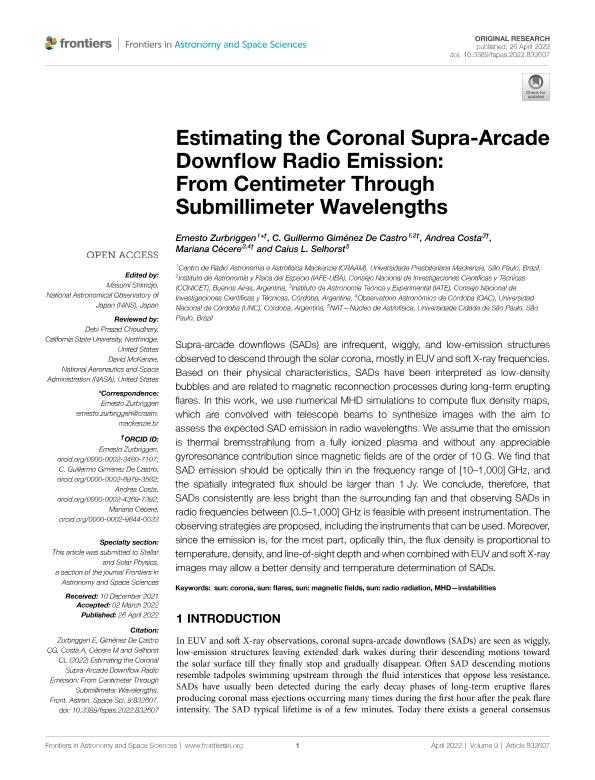Mostrar el registro sencillo del ítem
dc.contributor.author
Zurbriggen, Ernesto

dc.contributor.author
Giménez de Castro, C. Guillermo
dc.contributor.author
Costa, Andrea

dc.contributor.author
Cécere, Mariana Andrea

dc.contributor.author
Selhorst, Caius L.
dc.date.available
2023-07-10T12:40:04Z
dc.date.issued
2022-04
dc.identifier.citation
Zurbriggen, Ernesto; Giménez de Castro, C. Guillermo; Costa, Andrea; Cécere, Mariana Andrea; Selhorst, Caius L.; Estimating the Coronal Supra-Arcade Downflow Radio Emission: From Centimeter Through Submillimeter Wavelengths; Frontiers Media; Frontiers in Astronomy and Space Sciences; 9; 832607; 4-2022; 1-11
dc.identifier.uri
http://hdl.handle.net/11336/202866
dc.description.abstract
Supra-arcade downflows (SADs) are infrequent, wiggly, and low-emission structures observed to descend through the solar corona, mostly in EUV and soft X-ray frequencies. Based on their physical characteristics, SADs have been interpreted as low-density bubbles and are related to magnetic reconnection processes during long-term erupting flares. In this work, we use numerical MHD simulations to compute flux density maps, which are convolved with telescope beams to synthesize images with the aim to assess the expected SAD emission in radio wavelengths. We assume that the emission is thermal bremsstrahlung from a fully ionized plasma and without any appreciable gyroresonance contribution since magnetic fields are of the order of 10 G. We find that SAD emission should be optically thin in the frequency range of [10–1,000] GHz, and the spatially integrated flux should be larger than 1 Jy. We conclude, therefore, that SADs consistently are less bright than the surrounding fan and that observing SADs in radio frequencies between [0.5–1,000] GHz is feasible with present instrumentation. The observing strategies are proposed, including the instruments that can be used. Moreover, since the emission is, for the most part, optically thin, the flux density is proportional to temperature, density, and line-of-sight depth and when combined with EUV and soft X-ray images may allow a better density and temperature determination of SADs.
dc.format
application/pdf
dc.language.iso
eng
dc.publisher
Frontiers Media

dc.rights
info:eu-repo/semantics/openAccess
dc.rights.uri
https://creativecommons.org/licenses/by/2.5/ar/
dc.subject
MHD—INSTABILITIES
dc.subject
SUN: CORONA
dc.subject
SUN: FLARES
dc.subject
SUN: MAGNETIC FIELDS
dc.subject
SUN: RADIO RADIATION
dc.subject.classification
Astronomía

dc.subject.classification
Ciencias Físicas

dc.subject.classification
CIENCIAS NATURALES Y EXACTAS

dc.title
Estimating the Coronal Supra-Arcade Downflow Radio Emission: From Centimeter Through Submillimeter Wavelengths
dc.type
info:eu-repo/semantics/article
dc.type
info:ar-repo/semantics/artículo
dc.type
info:eu-repo/semantics/publishedVersion
dc.date.updated
2023-07-06T11:24:30Z
dc.identifier.eissn
2296-987X
dc.journal.volume
9
dc.journal.number
832607
dc.journal.pagination
1-11
dc.journal.pais
Suiza

dc.journal.ciudad
Lausana
dc.description.fil
Fil: Zurbriggen, Ernesto. Consejo Nacional de Investigaciones Científicas y Técnicas. Oficina de Coordinación Administrativa Ciudad Universitaria. Instituto de Astronomía y Física del Espacio. - Universidad de Buenos Aires. Facultad de Ciencias Exactas y Naturales. Instituto de Astronomía y Física del Espacio; Argentina. Universidade Presbiteriana Mackenzie; Brasil
dc.description.fil
Fil: Giménez de Castro, C. Guillermo. Consejo Nacional de Investigaciones Científicas y Técnicas. Oficina de Coordinación Administrativa Ciudad Universitaria. Instituto de Astronomía y Física del Espacio. - Universidad de Buenos Aires. Facultad de Ciencias Exactas y Naturales. Instituto de Astronomía y Física del Espacio; Argentina
dc.description.fil
Fil: Costa, Andrea. Universidade Presbiteriana Mackenzie; Brasil. Consejo Nacional de Investigaciones Científicas y Técnicas. Centro Científico Tecnológico Conicet - Córdoba. Instituto de Astronomía Teórica y Experimental. Universidad Nacional de Córdoba. Observatorio Astronómico de Córdoba. Instituto de Astronomía Teórica y Experimental; Argentina
dc.description.fil
Fil: Cécere, Mariana Andrea. Consejo Nacional de Investigaciones Científicas y Técnicas. Centro Científico Tecnológico Conicet - Córdoba. Instituto de Astronomía Teórica y Experimental. Universidad Nacional de Córdoba. Observatorio Astronómico de Córdoba. Instituto de Astronomía Teórica y Experimental; Argentina. Universidad Nacional de Córdoba. Observatorio Astronómico de Córdoba; Argentina
dc.description.fil
Fil: Selhorst, Caius L.. Consejo Nacional de Investigaciones Científicas y Técnicas; Argentina
dc.journal.title
Frontiers in Astronomy and Space Sciences
dc.relation.alternativeid
info:eu-repo/semantics/altIdentifier/url/https://www.frontiersin.org/articles/10.3389/fspas.2022.832607/full
dc.relation.alternativeid
info:eu-repo/semantics/altIdentifier/doi/https://doi.org/10.3389/fspas.2022.832607
Archivos asociados
